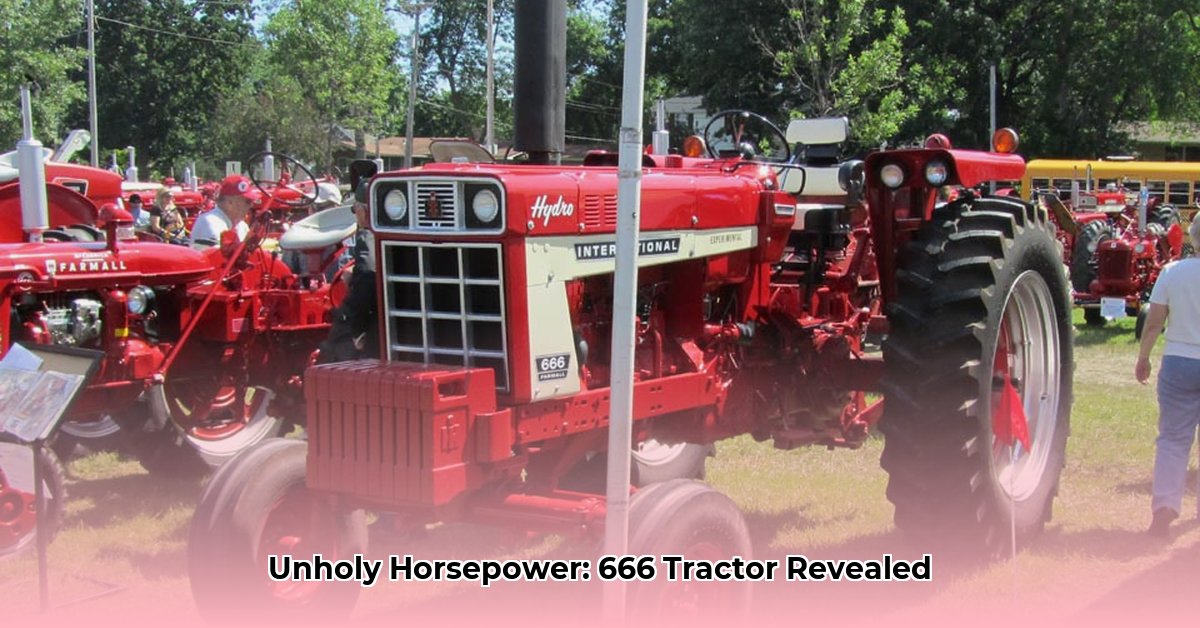
The International Harvester 666: a name whispered with reverence among agricultural machinery enthusiasts. This powerful machine, a stalwart of the 1970s farming landscape, deserves more than a cursory glance. For more on classic tractors, see this helpful resource: 1950s Farmall Tractors. This article provides a deep dive into its specifications, historical context, and current value, addressing the challenges of researching this relatively rare tractor. We aim to offer a comprehensive analysis, acknowledging the limitations imposed by the scarcity of readily available data.
Unveiling the International 666's Technical Prowess
The International 666, produced between 1972 and 1976, commanded attention with its claimed 75 horsepower engine – a significant output for its era. While the advertised horsepower represents the engine's potential, actual power delivered to the wheels and power take-off (PTO) likely varied. Farmers could choose between gasoline and diesel engines, a strategic option given the volatile fuel prices of the time. This flexibility allowed for customization depending on fuel costs and operational needs.
Transmission choices further enhanced its versatility. Some 666s featured traditional gear-based systems, while others incorporated more advanced hydrostatic transmissions, providing smoother, more controlled speed adjustments. Comfort and safety were also prioritized, with features like power steering, dependable disc brakes, and the option of roll-over protection structures (ROPS), canopies, and air-conditioned cabs. The convenient "Fast Hitch" system expedited implement changes, significantly boosting efficiency. This blend of power, flexibility, and operator convenience established the 666 as a formidable competitor in the agricultural machinery market. But how did it stack up against its rivals?
Benchmarking the 666: A Comparative Look
Direct performance comparisons against contemporary tractors from John Deere, Ford, and Massey Ferguson prove challenging due to the limited availability of comprehensive, cross-manufacturer data from this period. While precise figures are elusive, anecdotal evidence from online forums and enthusiast communities suggests the 666 held its own. Its reliability and capability are frequently highlighted. However, the overall performance and longevity were heavily dependent on maintenance and operating conditions: a well-maintained 666 could provide years of service, while neglect would significantly shorten its lifespan. Further research is needed to fully quantify its competitive advantages and disadvantages.
| Feature | International 666 | Potential John Deere Competitor | Potential Ford Competitor | Potential Massey Ferguson Competitor |
|---|---|---|---|---|
| Horsepower | 75 hp (claimed), higher drawbar and PTO HP | Further Research Needed | Further Research Needed | Further Research Needed |
| Transmission | Gear and Hydrostatic options available | Further Research Needed | Further Research Needed | Further Research Needed |
| Key Features | Fast Hitch, optional air conditioning | Further Research Needed | Further Research Needed | Further Research Needed |
| Engine Type | Gasoline and Diesel options available | Further Research Needed | Further Research Needed | Further Research Needed |
(This table requires further data to effectively compare the International 666 to competitors.)
A Product of its Time: The 666 in Historical Context
The International 666’s production run (1972-1976) coincided with a period of significant agricultural transformation. Fluctuating fuel prices significantly impacted farming practices, making the availability of both gasoline and diesel engine options a crucial selling point. The 666 faced stiff competition from established players like John Deere and Ford, creating a highly dynamic and fiercely competitive market. Understanding its market position relative to its contemporaries requires further research to analyze sales figures, market share, and farmer feedback surrounding its features and capabilities. This deeper analysis would reveal the 666’s overall success and impact on the agricultural landscape.
Did its innovative design offset any inherent weaknesses? What aspects particularly resonated with farmers of that era? These questions remain open for further investigation.
Rarity and Value: The Collector's Perspective
The International 666 was not a mass-produced machine; estimates suggest a production run of approximately 9,367 units. This relative scarcity has made it a highly sought-after item among collectors. However, this rarity presents inherent challenges; locating parts for restoration can be extremely difficult, often requiring extensive searching and networking with fellow enthusiasts. The limited numbers, coupled with increasing collector interest, drives up the value. While the financial appreciation is significant, the historical significance of a restored 666 adds another layer of value, transcending purely monetary considerations.
Research Limitations and Future Directions
A significant obstacle faced in this research is the limited availability of photographic and visual documentation. This lack significantly impacts the visual understanding of the International 666’s features and design characteristics, making cross-comparisons with competitor models difficult to perform with confidence. Further investigation into archives and private collections is essential to enhance the existing knowledge base. The current overview, while informative, is far from complete; it sets the stage for future research to comprehensively catalog and analyze this fascinating piece of agricultural history. The story of the International 666 is still unfolding.
Conclusion
The International Harvester 666 tractor, a product of its time, remains a compelling example of agricultural machinery innovation. While this analysis provides key insights into its technical specifications, historical context, and collector value, gaps in available data necessitate further research. The scarcity of visual documentation and detailed performance comparisons underscores the need for continued investigation to fully appreciate the 666’s contribution to the agricultural evolution of the 1970s.